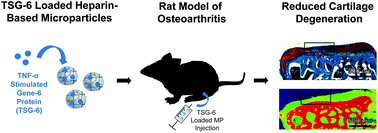当前位置:
X-MOL 学术
›
Biomater. Sci.
›
论文详情
Our official English website, www.x-mol.net, welcomes your
feedback! (Note: you will need to create a separate account there.)
Intra-articular TSG-6 delivery from heparin-based microparticles reduces cartilage damage in a rat model of osteoarthritis†
Biomaterials Science ( IF 5.8 ) Pub Date : 2018-03-14 00:00:00 , DOI: 10.1039/c8bm00010g Liane E. Tellier 1, 2, 3, 4 , Elda A. Treviño 1, 2, 3, 4 , Alexandra L. Brimeyer 1, 2, 3, 4 , David S. Reece 1, 2, 3, 4 , Nick J. Willett 1, 2, 3, 4, 5 , Robert E. Guldberg 3, 4, 6, 7, 8 , Johnna S. Temenoff 1, 2, 3, 4, 6
Biomaterials Science ( IF 5.8 ) Pub Date : 2018-03-14 00:00:00 , DOI: 10.1039/c8bm00010g Liane E. Tellier 1, 2, 3, 4 , Elda A. Treviño 1, 2, 3, 4 , Alexandra L. Brimeyer 1, 2, 3, 4 , David S. Reece 1, 2, 3, 4 , Nick J. Willett 1, 2, 3, 4, 5 , Robert E. Guldberg 3, 4, 6, 7, 8 , Johnna S. Temenoff 1, 2, 3, 4, 6
Affiliation

|
As a potential treatment for osteoarthritis (OA), we have developed injectable and hydrolytically degradable heparin-based biomaterials with tunable sulfation for the intra-articular delivery of tumor necrosis factor-alpha stimulated gene-6 (TSG-6), a protein known to inhibit plasmin which may degrade extracellular matrix within OA joints. We first assessed the effect of heparin sulfation on TSG-6 anti-plasmin activity and found that while fully sulfated (Hep) and heparin desulfated at only the N position (Hep−N) significantly enhanced TSG-6 bioactivity in vitro, fully desulfated heparin (Hep−) had no effect, indicating that heparin sulfation plays a significant role in modulating TSG-6 bioactivity. Next, TSG-6 loaded, degradable 10 wt% Hep−N microparticles (MPs) were delivered via intra-articular injection into the knee at 1, 7, and 15 days following medial meniscal transection (MMT) injury in a rat model. After 21 days, cartilage thickness, volume, and attenuation were significantly increased with soluble TSG-6, indicating degenerative changes. In contrast, no significant differences were observed with TSG-6 loaded MP treatment, demonstrating that TSG-6 loaded MPs reduced cartilage damage following MMT injury. Ultimately, our results indicate that Hep−N can enhance TSG-6 anti-plasmin activity and that Hep−N-based biomaterials may be an effective method for TSG-6 delivery to treat OA.
中文翻译:

从基于肝素的微粒关节内TSG-6的递送减少了骨关节炎大鼠模型的软骨损伤†
作为骨关节炎(OA)的潜在治疗方法,我们已经开发出可注射和可水解降解的基于肝素的生物材料,具有可调节的硫酸化作用,可在关节内递送肿瘤坏死因子-α刺激基因6(TSG-6)。抑制纤溶酶可能会降解OA关节内的细胞外基质。我们首先评估了肝素硫酸化对TSG-6抗纤溶酶活性的影响,发现虽然完全硫酸化(Hep)和肝素仅在N位脱硫(Hep -N)可以显着增强体外TSG-6的生物活性,但完全脱硫的肝素(喉癌- )没有任何影响,表明肝素硫酸在调节TSG-6生物活性的显著作用。接下来,负载TSG-6,可降解10 wt%Hep -N在大鼠半月板内侧横切(MMT)损伤后第1、7和15天,通过关节内注射将微粒(MPs)输送至膝盖。21天后,可溶性TSG-6使软骨厚度,体积和衰减显着增加,表明退行性改变。相比之下,TSG-6载脂蛋白治疗未观察到显着差异,表明TSG-6载脂蛋白减少了MMT损伤后的软骨损伤。最终,我们的结果表明,Hep -N可以增强TSG-6抗纤溶酶的活性,并且基于Hep -N的生物材料可能是TSG-6递送治疗OA的有效方法。
更新日期:2018-03-14
中文翻译:

从基于肝素的微粒关节内TSG-6的递送减少了骨关节炎大鼠模型的软骨损伤†
作为骨关节炎(OA)的潜在治疗方法,我们已经开发出可注射和可水解降解的基于肝素的生物材料,具有可调节的硫酸化作用,可在关节内递送肿瘤坏死因子-α刺激基因6(TSG-6)。抑制纤溶酶可能会降解OA关节内的细胞外基质。我们首先评估了肝素硫酸化对TSG-6抗纤溶酶活性的影响,发现虽然完全硫酸化(Hep)和肝素仅在N位脱硫(Hep -N)可以显着增强体外TSG-6的生物活性,但完全脱硫的肝素(喉癌- )没有任何影响,表明肝素硫酸在调节TSG-6生物活性的显著作用。接下来,负载TSG-6,可降解10 wt%Hep -N在大鼠半月板内侧横切(MMT)损伤后第1、7和15天,通过关节内注射将微粒(MPs)输送至膝盖。21天后,可溶性TSG-6使软骨厚度,体积和衰减显着增加,表明退行性改变。相比之下,TSG-6载脂蛋白治疗未观察到显着差异,表明TSG-6载脂蛋白减少了MMT损伤后的软骨损伤。最终,我们的结果表明,Hep -N可以增强TSG-6抗纤溶酶的活性,并且基于Hep -N的生物材料可能是TSG-6递送治疗OA的有效方法。











































 京公网安备 11010802027423号
京公网安备 11010802027423号